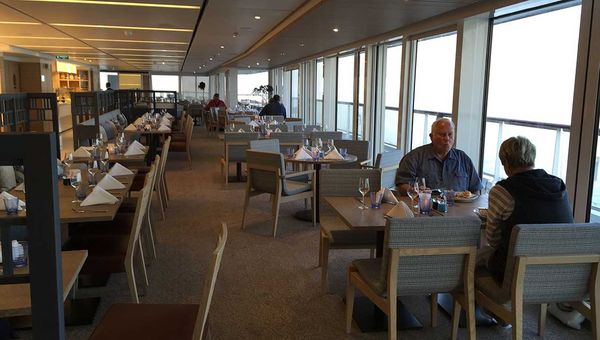ABOARD THE VIKING STAR — Anyone who has traveled the rivers
of Europe on Viking River Cruises would be curious about how company’s new
ocean-going vessel stacks up.
It is easy to see the family resemblance between the two
types of Viking ships.
Viking’s standard Longship vessels have white exteriors and
spare, contemporary interiors designed with a Northern European sensibility
that is comfortable, clean and unfussy.
Viking Star, which left Istanbul on Sunday on the first leg
of a 50-night cruise to Stockholm, has much the same look and feel although
displayed on a much larger canvas.
Where Viking’s river ships have two-and-a-half decks of
passenger cabins, the ocean ship has six, giving it the capacity to carry 930
passengers, up from 190 on a river vessel.
The Star has 10 decks overall, giving it more and bigger
public rooms than the river ships, and many extras such as a theater, two
cinemas, a spa, a gym and a two pools, none of which are part of the Viking
river brand.
But the look and feel of the two types of ships conform to
the tastes of Viking Cruises Chairman Torstein Hagen, who has built the Viking
brand into a powerhouse in river cruising.
Viking Star’s look bears the same Scandinavian modern
influence seen in the river ships. The colors are muted and neutral, with blues
and browns predominating. Tans, beiges, taupes and off-white shades are also in
evidence.

Guests can sample a variety of regional specialties at the World Cafe. Photo Credit: Tom Stieghorst
Cabins and public spaces are trimmed in a blonde wood, with
touches of leather such as the covering for the staircase handrails.
Chandeliers and light fixtures are modern, but not aggressively so.
Art pieces on the ship are also contemporary, but in a way
that doesn’t make them stand apart from the overall design. Some have Viking
references, such as the staircase landing’s centerpieces based on tapestries
depicting the Norman invasion of England in 1066.
Like the river ships, Viking Star has a simple but
impressively wide grand staircase that dominates a central atrium. The one on
Viking Star sets off a very large LED screen that offers changing images, such
as one of the spiral decorative prow of a medieval Viking Longship.
There are decorative horizontal racks of light wood that
surround the elevators on each deck.
The main public spaces on Deck 7 of the ship benefit from a
lot of glass that give them an airy and spacious feel, similar to the feel of
the Longship atrium that is partly roofed in glass.
Viking Star’s main restaurant has comfortable, upholstered
chairs and the neutral colors that are also reminiscent of the dining area on
the river ships. The ship’s buffet restaurant has an indoor/outdoor capacity
with an Aquavit Terrace that accommodates al fresco dining.
As on the river ships, the tile floors in the bathrooms on
Viking Star are heated. The patterns in the stone surfaces decorating the
bathroom are barely discernable. The basins are rectangular and white, and the
fixtures are squared-off and contemporary.
One of the few elaborate touches is a sort of corded webbing
that covers the windows along the exterior of the atrium. There is also a
filigree screen here and there, such as the one that forms the backing for the
stage by the main pool on Deck 7.
All in all, the Viking Star is a more spacious and expanded
version of the design formula that has worked well for Viking Cruises for the
past 20 years on the inland waterways of Europe.